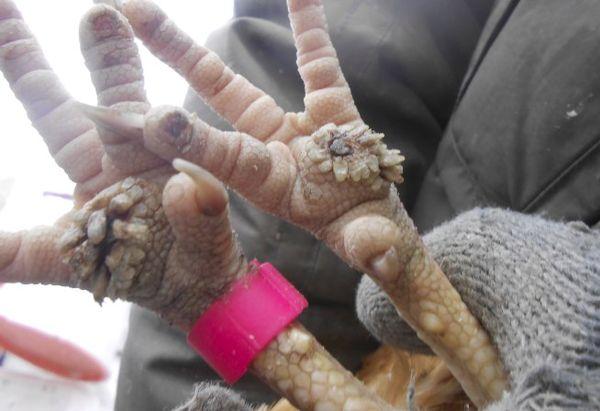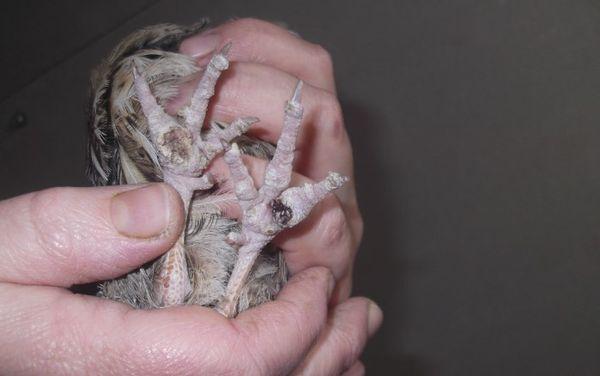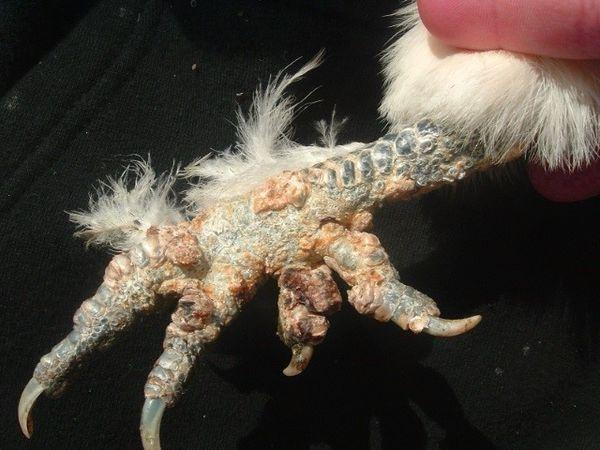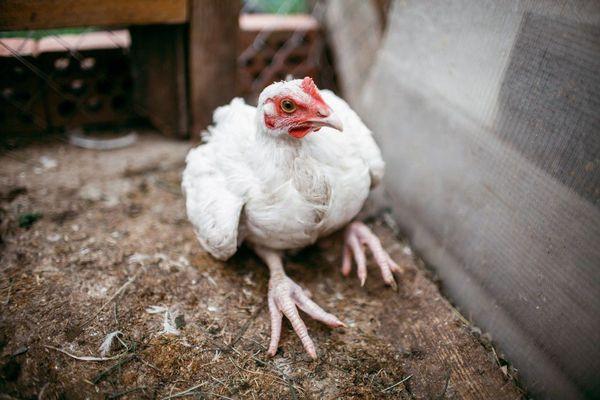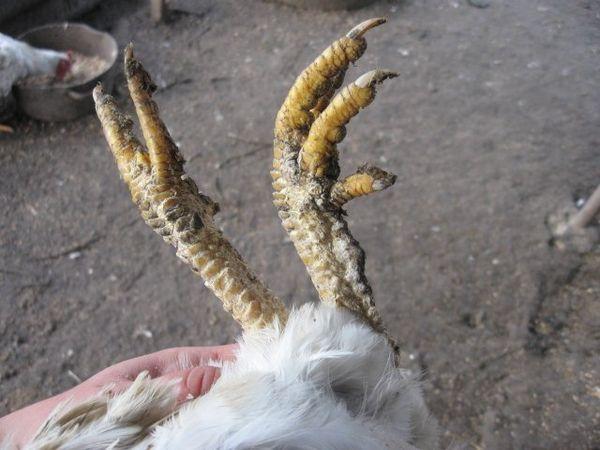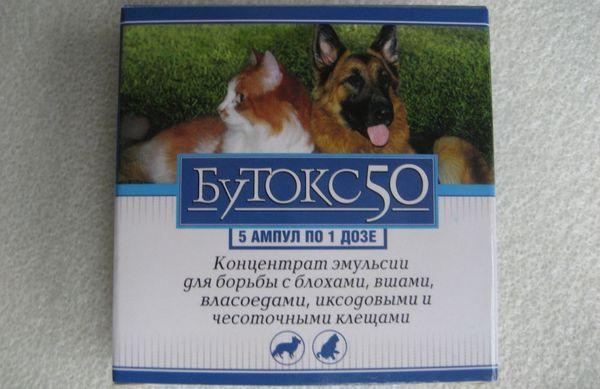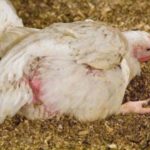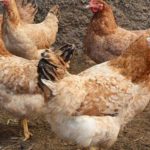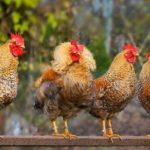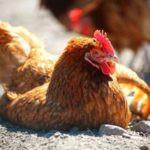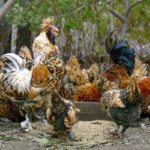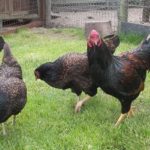The paws of poultry are one of the vulnerable places for infection. Lameness, restlessness, decreased egg production and weight should alert the farmer to determine the cause of the pathological phenomenon. How to treat growths on the legs of chickens depends on the diagnosis. Timely measures taken will help prevent the spread of the disease. Inattention to raising livestock can lead to mass mortality.
Description of the disease
Growths on the legs of chickens can appear in several cases:
- with knemidocoptosis;
- gout;
- corns;
- vitamin deficiency.
Knemidocoptic mange is a contagious disease known as scabies, “lime foot”. The causative agent is the Knemidocopt mite, a gray-yellow parasite, ranging in size from 1/10 to 4/10 of a millimeter. The insect affects chickens in the warm season: from late May to mid-September.
The tick breaks through passages in the integumentary membranes of the legs, reaching the epithelial tissue. Chickens older than 5 months are most susceptible to infection. The parasite feeds on the subcutaneous tissue, never coming to the surface. Exudate appears in the damaged scaly covering of chicken feet, which indicates the beginning of the inflammatory process.
The accumulation of lymph causes the formation of a tumor that compresses the paw tissue. The bird first feels severe itching and then pain in its legs. Poor circulation without timely treatment leads to necrosis of the toes and death of the chicken. A sick bird is a source of infection, pecking at painful spots on its feet and spreading mites throughout the chicken coop.
The name of the pathology is “calcareous foot”, due to the change in color of the scales. The chicken uses its beak to inflict mechanical injury on itself in the place where the mite and larvae are located. A film forms on the wound, and then thickened, loosely fitting white-gray scales.
Behavior of sick chickens:
- restless;
- no appetite;
- often stand on one leg, squeezing and unclenching their toes;
- peck their paws into blood.
When examining the birds, changes in the color and thickness of the scales, growths between the toes, on the legs, cracks, and purulent discharge are noticeable. The disease affects the productivity and egg production of chickens.
Damage by scabies mites must be distinguished from gouty bumps, corns and manifestations of vitamin deficiency.
With gout, due to the deposition of salts, the joints in the legs swell and grow. Growths filled with pus form. At the same time, muscles, kidneys, and the digestive system are affected. The chickens begin to limp and fall. The leg joint loses mobility and becomes irreversibly deformed.
Corns are hard bumps that are painful when pressed and make it difficult for chickens to walk. Cracking of growths leads to infection of the bird's body with staphylo- and streptococci.
A lack of vitamin A in chicken feed leads to thickening of the sole, vitamin B and manganese - to a growth in the hock joint. A tumor on the leg may appear after a bruise, provoking the further development of tenosynovitis (inflammation of the tendon sheath) with the formation of a growth.
Causes of growths on paws
Factors influencing the formation of “calcareous foot” are a complex of violations in the keeping of chickens:
- Increased temperature and humidity in the chicken coop.
- Untimely change of litter.
- Rare disinfection of feeders, drinking bowls, and equipment.
- Insufficient content of vitamins in the feed.
The cause of urolithiasis (gout) in chickens is an unbalanced diet: the predominance of proteins in the diet.
Corns are formed due to uneven distribution of load on the paws when chickens are kept in cages or on very hard surfaces. Lack of vitamins A, B, and microelements affects the condition of bones and joints.
Knemidocoptic mange is a contagious and most dangerous disease when keeping chickens.
Stages of development
Manifestations of scabies depend on the phase of the disease and the age of the chickens.
Asymptomatic
The duration of the stage is up to 4-6 months. The place of penetration of the parasite is the area of the hock joint. Externally, infection in chickens is not determined.
Papular
The duration of the disease without treatment is 12-24 months.Nodular growths form under the scaly cover, making the surface lumpy. Chickens' feet acquire a gray-white coating. Symptoms of scabies appear. Due to pain, the bird often stands on one leg and limps.
Rustic
Last stage. There is deformation of the legs, falling off of scales with the formation of bleeding deep cracks. Chicken feet turn brown due to dried secretions. The waste products and decomposition of mites cause inflammation of the joints to the point of necrosis and loss of phalanges.
How are chickens treated?
The detection of growths on the paws of chickens indicates the second phase of knemidocoptosis, in which a sick bird becomes a spreader of scabies mites. Suspicious individuals require isolation, clarification of the diagnosis and initiation of treatment.
The rest of the chicken population must be inspected in order to carry out quarantine measures. In the chicken coop, the bedding is replaced, the floor covering, drinking bowls, feeders, nests, perches, and equipment are disinfected. The food will have to be adjusted.
Treatment of gout consists of introducing greens, sprouted wheat grains into the poultry's complementary foods, and feeding them with a soda solution for 14 days. Corns on the feet are softened with Vaseline. Bruises and wounds are treated with healing ointments.
Drug therapy
To treat scabies, anti-mite drugs are used, mainly based on synthetic pyrethroid.
Ectomin
Designed to destroy ectoparasites. Available in the form of a 10% emulsion. Moderately toxic. The concentration of the solution is 10 milliliters per 10 liters. Liquid temperature – 15-25 degrees, indoors/outdoors – not lower than 12 degrees. The exposure time for paws with growths is from 30 to 60 seconds.Chickens should not swallow the medicine.
Trichlorometaphos
A broad-spectrum drug with moderate toxicity for warm-blooded animals. It is quickly absorbed and remains in tissues for a long time. It is excreted from the body of chickens in feces and eggs. To treat growths, prepare a 0.25% emulsion: 250 grams per 50 liters of water.
Butox
If parasites are detected, prepare a bath for the chickens to bathe. An aqueous emulsion is prepared immediately before processing. Concentration – 0.025% or 1 ampoule per liter of water. The mixture is stirred for 20 minutes. Place the chickens' legs in the container for a few seconds.
Butox is used for aerosol disinfestation of chicken coops in the presence of birds. Per 100 square meters, 5 liters of solution in the same concentration are required.
Mara Garden
The drug is a ready-to-use oil solution that is used to treat the paws of a sick chicken. The drug has a detrimental effect on ticks and larvae and helps restore scales.
Akarin
Akarin is a broad-spectrum nerve poison with low toxicity to humans and warm-blooded animals. Do not use if there are open cracks on the paws. The concentration of the solution against scabies mites is 2 milliliters per liter of water.
Frontline
The spray is intended to destroy ectoparasites, including scabies mites. Not used in the third stage of knemidocoptosis, in case of exhaustion, concomitant infections. A single spray on the affected legs is sufficient.
Folk remedies
Non-medicinal remedies that are effective for scabies are birch tar and grease. Before applying the tar, the chickens' paws are kept in a warm soapy solution (from laundry soap) for 10-15 minutes. Then the legs are lubricated with tar up to the hock joint.The manipulation is repeated twice, every other week. A mixture of grease and vegetable oil (1:10) is applied to the affected areas 2 times a day for half a month.
Consequences and prevention
In advanced cases, when the disease has reached the rustic stage, the bird is sent for slaughter.
Prevention against knemidocoptosis is general:
- regular cleaning;
- disinfection of the premises with anti-mite agents;
- ventilation;
- lighting;
- possibility of free walking;
- balanced, high-quality feed;
- quarantine of new livestock;
- periodic inspection of chickens for infection;
- preventive treatment of paws of healthy birds against ticks.
If more than 10% of the chicken population is affected by knemidocoptic mange, then a complete replacement of the flock is recommended due to the high risk of re-infection.

